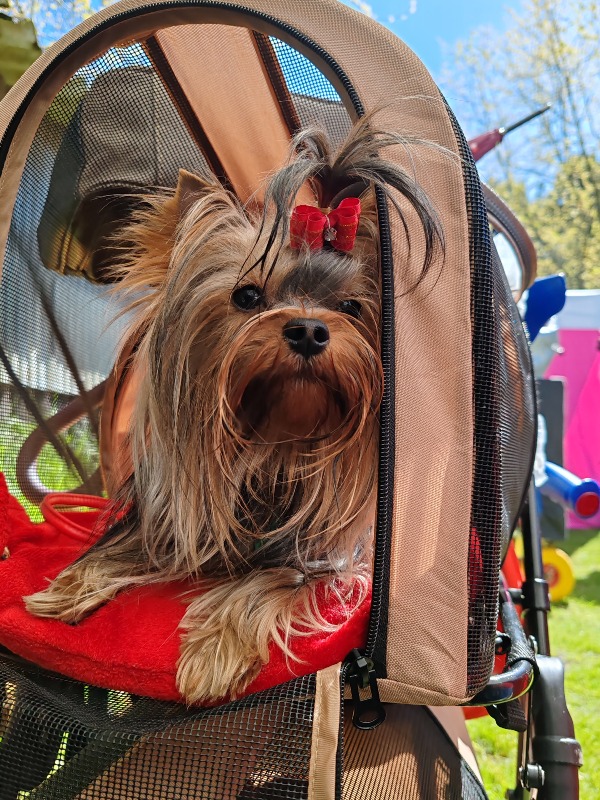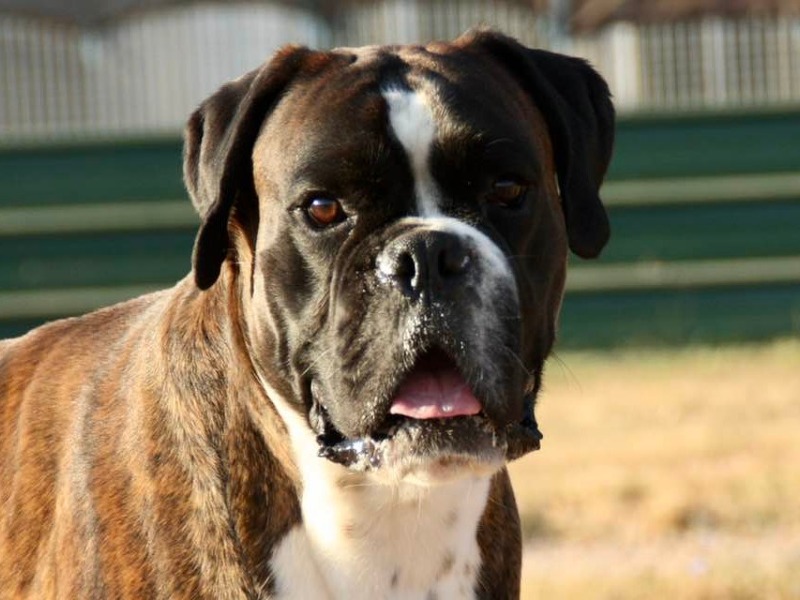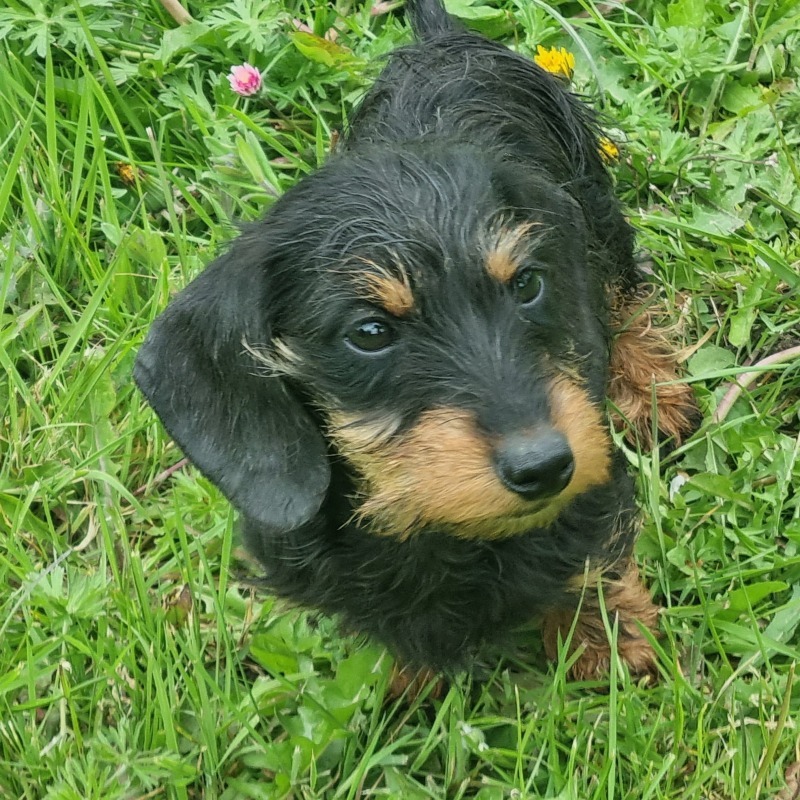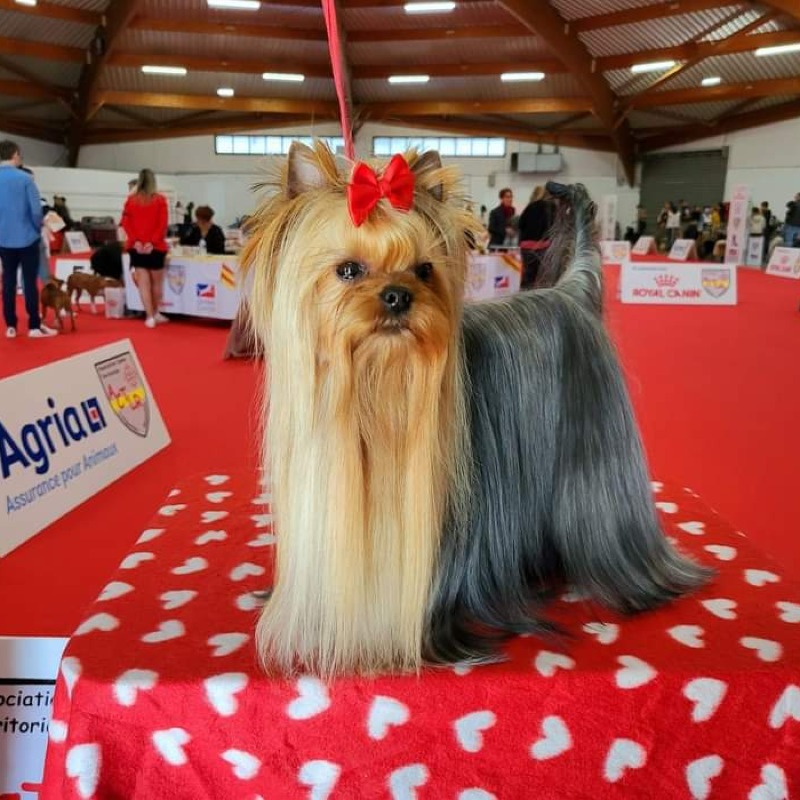Yorkshire terrier
Welcome to our page dedicated to the breed of dog yorkshire terrier!
Here, you will find all the useful information about yorkshire terrier. This descriptive profile will allow you to discover the aspects of this breed. You can notably consult information about the average price, monthly and annual upkeep expenses, their health, name ideas, as well as their official recognition by competent authorities.
Explore this page to discover everything you need to know.
Overall description of the breed
The Yorkshire Terrier originates from the eponymous county in England. This lively little dog emerged in the 19th century due to the massive influx of Scottish workers during the second industrial revolution in the United Kingdom. Scottish dogs were often known for their small size, robustness, and tenacity in work. Over time, through rigorous selection by breeders, the ancestor of the Yorkshire Terrier was crossed with local dogs such as the Maltese Bichon, giving rise to alert, agile, and fearless dogs perfectly suited for pest hunting in mines.
After decades of hard work, the Yorkshire Terrier was frequently employed as a rat hunter, used to chase rabbits and mice. It proved particularly adept at maneuvering through steep or hard-to-access galleries, marking the birth of the Yorkshire Terrier breed. In 1898, it was officially recognized and registered by the Fédération Cynologique Internationale (FCI). On October 30, 1954, it was definitively registered, and its current standard was published on November 10, 2011.
The Yorkshire Terrier is one of the smallest dog breeds in the world, but despite its diminutive size, it possesses a sturdy build. Its morphology is short, compact, and harmonious overall. Its withers height is roughly equal to the length of its body. However, it's worth noting that females generally have a slightly longer body than males. Its head is round, the skull slightly domed, and its muzzle is narrow and of medium size, adorned with a beard of fur that frames the lower part of its face.
Its round, medium-sized eyes are always bright and dark in color, giving it an open and mischievous gaze. Its ears are small, upright, and shaped like a V. The coat color of the Yorkshire Terrier is steel blue on the head and trunk, while it's fawn (reddish-brown) on the legs and around the muzzle. Its fur is long and incredibly smooth, offering a soft and silky texture to the touch. The long fringes of its fur were particularly helpful when it was used for hunting, making it easier to extract from the burrows it had entered.
Once a hunter, the Yorkshire Terrier is now exclusively considered a joyful and affectionate companion. Expressive, it won't miss an opportunity to show its love and affection. Although naturally wary, it needs time to build trust. Once earned, it will bond to its family in a deeply attached manner. Intelligent and playful, it will greatly enjoy sharing playtime with its owners and will always be enthusiastic about going for walks or accompanying you in your activities.
It's important to note that the Yorkshire Terrier demands a lot of attention and doesn't tolerate solitude well. Prolonged absences could have negative effects on its well-being. After a fulfilling day, it will love spending hours snuggled up on the couch next to you. Its presence by your side is crucial for its balance. It's advisable not to encourage this behavior by teaching it to be alone occasionally. As an extremely popular companion dog, it's one of the most widespread dog breeds in the world. Its reputation as an ideal companion is recognized by all, and thanks to its affectionate nature, it will certainly continue to bring happiness to many families!
In adulthood, the Yorkshire Terrier typically weighs between 2 and 3 kg (4 to 6 lb) and measures
Awareness of acquiring an animal
Each animal is a sensitive being, deserving love, attention and care.
When you choose to adopt an animal, you take on the responsibility of ensuring its health and well-being throughout its life.
To learn more about animal welfare, we invite you to consult our FAQ by clicking the button below:
Origins
The Yorkshire Terrier, often called "Yorkie", originates from the county of Yorkshire in England. This breed was developed in the 19th century by Scottish workers who came to work in the textile industries in the region. They crossed several small terrier breeds, including the Waterside Terrier, the Clydesdale Terrier, and perhaps the Skye Terrier, in order to create a small dog capable of hunting rats and other pests in cotton mills and mines. The Yorkshire Terrier was thus born out of this practical need, combined with careful breeding to obtain an elegant appearance and silky coat.
History
The history of the Yorkshire Terrier is closely linked to the industrial era of England. The first traces of this breed date back to the 1860s. The Yorkshire Terrier quickly gained popularity, first as a vermin hunter, then as a pet thanks to its elegant appearance and charming character. In 1886, the British Kennel Club officially recognized the breed, allowing Yorkshire Terriers to participate in dog shows and become known to the general public. The Yorkshire Terrier quickly became a popular companion dog among the wealthy classes, due to its small size and lush coat, contributing to its status as a luxury dog.
Standard
The standard for the Yorkshire Terrier breed is strictly defined by dog clubs to preserve its distinctive characteristics. According to the Kennel Club, the Yorkshire Terrier should have a compact and well-proportioned body. Males and females should measure approximately 18 to 23 cm at the withers. The weight should not exceed 3.2 kg. The coat is smooth, silky, and falls straight on each side of the body, from the nose to the tail. The standard color is dark steel blue and tan, without any black hairs. The head should be small and flat, with dark and expressive eyes and small, V-shaped, erect ears.
Physical characteristics
The Yorkshire Terrier is a small-sized dog. Males and females measure between 18 and 23 cm in height at the withers and weigh between 2.5 and 3.2 kg. Their coat is long, straight and silky, falling perfectly on each side of the body. The color of the coat is a key characteristic, with a dark steel blue hue on the body and a rich fire color on the chest and legs. The hair on the head is often tied with a knot to prevent it from falling into the eyes. The eyes are dark, bright and lively, and the ears are small, V-shaped, and usually erect.
Character
The Yorkshire Terrier is known for its lively, bold, and affectionate character. Despite its small size, the Yorkie is brave and can be very protective of loved ones. They are also intelligent and curious, always ready to explore their surroundings. Yorkies are often described as alert and energetic dogs, with a personality that far exceeds their modest size. They can be a bit stubborn, but their desire to please their owners makes them relatively easy to train with positive reinforcement methods. Their affectionate nature and need for companionship make them excellent pets for families and individuals alike.
Life expectancy
The Yorkshire Terrier generally enjoys a long life expectancy for a small breed dog, ranging between 12 and 15 years, and some can even live longer with proper care. The longevity of these dogs is largely attributed to their small size and good physical constitution. To maximize their life expectancy, it is essential to provide them with balanced nutrition, regular exercise, proper veterinary care, and plenty of love and attention. Regular monitoring to detect potential health problems at an early stage can also help prolong their healthy life.
Exercise and activity needs
Yorkshire Terriers, despite being small, need regular exercise to stay healthy and happy. They enjoy daily walks, play sessions, and interactive activities with their owners. A walk of about 20 to 30 minutes a day, along with play sessions, is usually sufficient to meet their exercise needs. Yorkies also enjoy playing indoors, which can be convenient for apartment dwellers. Exercise helps prevent boredom, which can lead to destructive behaviors, and helps maintain a healthy weight.
Recommended diet
The Yorkshire Terrier requires a balanced and high-quality diet suitable for its small size and activity level. Specific kibble for small breeds, rich in proteins and essential nutrients, is recommended. It is important to control portions to avoid overweight, a common issue in small dogs. A monthly budget for a Yorkshire Terrier's food typically ranges from 20 to 40 euros, depending on the chosen quality of food. Treats can be used for training, but should be given in moderation to avoid disrupting the nutritional balance.
Training and obedience
Training Yorkshire Terriers should start at a young age to establish appropriate behaviors and prevent behavior problems. Thanks to their intelligence and desire to please, Yorkies respond well to positive reinforcement methods, such as praise and food rewards. Socialization is also crucial to help them become well-balanced dogs comfortable with different people, animals, and environments. Training sessions should be short and varied to maintain their interest. Patience and consistency are essential, as these small dogs can sometimes be stubborn.
Behavior with children
Yorkshire Terriers can be good companions for children, especially if they are socialized and accustomed to young people from an early age. However, due to their small size and delicate nature, it is important to supervise interactions between Yorkies and young children to avoid accidents. Children should be taught to handle the dog gently and respectfully, without sudden movements or rough play. When both parties understand and respect each other's boundaries, Yorkies can form very strong and affectionate bonds with children.
Compatibility with Other Animals
Yorkshire Terriers can live well with other pets if they are socialized correctly from a young age. Their friendly nature and curiosity usually make them open to meeting new companions, whether it be other dogs or cats. However, due to their terrier instinct, they may sometimes be inclined to chase smaller animals. A gradual introduction under supervision is recommended to ensure that all interactions go smoothly. With time and patience, Yorkies can get along and live harmoniously with other animals in the household.
Grooming needs
The Yorkshire Terrier has a long and silky coat that requires regular maintenance to avoid knots and tangles. Daily brushing is recommended to maintain the beauty and health of the coat. In addition, regular baths, approximately once a month, help to keep the coat clean and shiny. Yorkies may also need professional haircuts every few weeks to manage the length of their coat. It is important to regularly check and clean their ears to prevent infections, brush their teeth to avoid dental problems, and trim their nails to prevent them from becoming too long.
Health
Yorkshire Terriers are generally robust dogs, but like all breeds, they can be prone to certain health problems. Common conditions include dental issues, luxating patellas, collapsed trachea, and liver diseases. They may also be sensitive to skin allergies and ear infections. Regular veterinary care, including professional dental cleanings, is essential to prevent these problems. A balanced diet and periodic health examinations help maintain their overall well-being and detect potential health issues early.
Average price
The average price of a Yorkshire Terrier can vary depending on several factors, including lineage, pedigree, breeder reputation, and region. In general, a pet Yorkshire Terrier costs between 800 and 1500 euros. Dogs intended for shows or from prestigious bloodlines can cost much more, sometimes up to 3000 euros or more. It is important to choose a reputable breeder who follows health and animal welfare standards. Initial costs may also include expenses for vaccination, sterilization, and first veterinary exams.
Expenses
Monthly expenses for a Yorkshire Terrier can vary, but generally range between 50 and 100 euros. This budget includes the cost of food, regular veterinary care, grooming products, and toys or accessories. Annual veterinary visits for vaccines and health check-ups are essential to maintain your dog's health. Other potential costs may include parasite treatments, dental care, and pet insurance. Adequate budget planning is important to ensure the ongoing well-being of your Yorkshire Terrier.
Name ideas
Choosing a name for your Yorkshire Terrier can be fun and reflect their unique personality. Here are some suggestions: Bella, Max, Charlie, Daisy, Rocky, Luna, Teddy, Molly, Leo, Sophie, Jack, Ruby, Milo, Chloe, Oscar, Nala, Lola, Simba, Archie, and Zoe. These names can suit different temperaments and appearances, offering a variety of choices to find the perfect name for your new companion. Remember that the name you choose should be easy to pronounce and recognize for your dog.
Legislation and regulation
In France, as in many other countries, there is no specific legislation concerning Yorkshire Terriers as a breed. However, it is compulsory to respect general laws on the protection of animals, which include requirements on vaccination, sterilization, and basic care. Breeders must be registered and comply with ethical and sanitary standards. In some countries, there may be specific regulations on the import and breeding of Yorkshire Terriers. It is advisable to check the current local and national laws to ensure compliance.
Official recognition
Yorkshire Terriers are recognized by many international canine organizations. The Kennel Club in the UK, the American Kennel Club (AKC) in the United States, and the Fédération Cynologique Internationale (FCI) in Europe are among the organizations that officially recognize this breed. These organizations establish breed standards and promote responsible breeding practices. Official recognition facilitates participation in dog shows and helps preserve breed standards.
Pedigrees
Several breed clubs and associations offer pedigrees for Yorkshire Terriers. In France, the Société Centrale Canine (SCC) is the official organization that issues pedigrees. In the United States, the American Kennel Club (AKC) also offers pedigrees for this breed. In Europe, the Fédération Cynologique Internationale (FCI) is another important organization. These breed clubs ensure the tracking of lineages and encourage ethical breeding practices to preserve the health and characteristics of the breed.
Destination and usage
Yorkshire Terriers are primarily bred as pets due to their affectionate temperament and elegant appearance. Their sociable nature and ability to adapt to different environments make them ideal companions for families, individuals, and the elderly. They are also popular in dog shows, where their unique features can be highlighted. Due to their alert and courageous temperament, they can also serve as good guard dogs to alert their owners of any suspicious activity.
Prohibitions
There are generally no specific prohibitions regarding the ownership of Yorkshire Terriers in most countries. However, it is important to inquire about local regulations regarding ownership and breeding of dogs. Some countries may have specific restrictions on importing and breeding certain dog breeds for public health or animal welfare reasons. It is essential to choose responsible breeders and to comply with local and national laws to ensure compliance.
Breeders ofYorkshire terrier
Want to see more breeders ofYorkshire terrier?
Check out the page of our directory listing all breeders ofYorkshire terrierClassified Ads ofyorkshire terrier
No ofyorkshire terrier classified ads are available on Preeders.
If you’re a breeder, sign up for free now and be the first to post a classified ad
Breed clubs ofyorkshire terrier
No ofyorkshire terrier breed clubs are currently registered on Preeders.
If you would like to highlight your breed club, sign up for free now and be the first to appear on this page.






